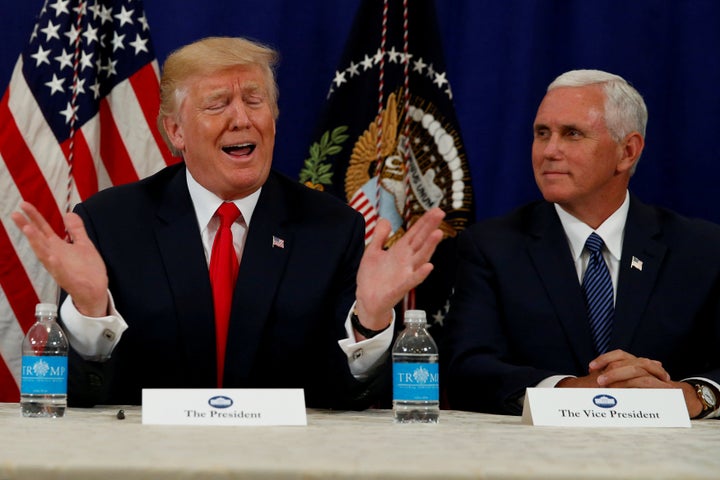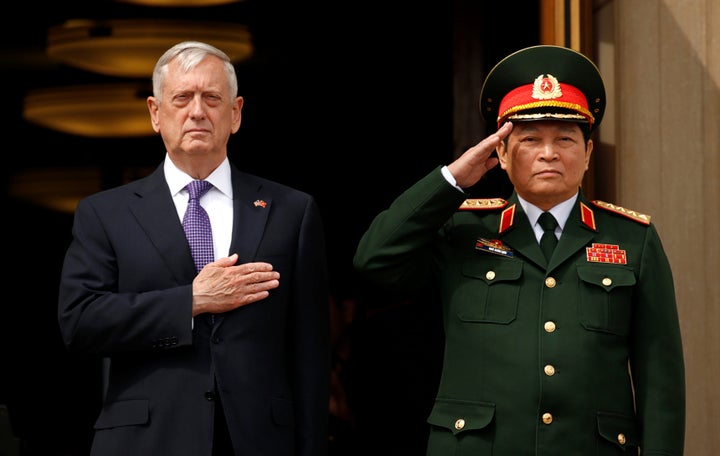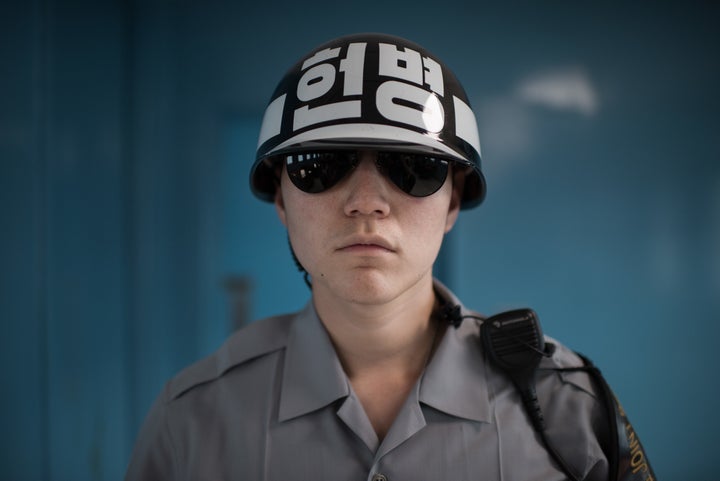The last few days have seen a host of threats, insults and posturing as North Korea and the USA square up to each other and teeter on the brink of nuclear annihilation (sort of).
Having warned Kim Jung Un that the state would experience a “fire and fury the likes the world has never seen”, before adding on Thursday that his threat may not have been “tough” enough.
Today he went further saying “military solutions are now fully in place, locked and loaded, should North Korea act unwisely”.
The President has also sought to back up his position with a bold claim about his country’s weapons arsenal and his role in strengthening it.
Only it’s not true - for a number of reasons.
Firstly, there’s the rather pedantic fact that the first order he signed was actually about Obamacare.
In fact it wasn’t until a week and 15 other orders later that he addressed the military and this was for a ‘Nuclear Posture Review’, a routine order for new presidents and not an increase in the arsenal.
This did not escape analyst, author and all-round expert-on-all-things-nuclear, Stephen Schwartz.
But as this is the age of Twitter and general distrust of experts, plenty of people took issue with Schwartz’s claim - and then regretted it.
Withering comebacks aside, Schwart’s entire thread is worth reading for an invaluable insight into the actual state of the US nuclear arsenal - and that of Trump’s tweet.
Undaunted by reality, Trump later doubled-down on his remarks with a largely nonsensical stream of alleged sentences.
Former Secretary of Energy Ernest Muniz, who managed the nation’s nuclear arsenal until Trump ’s inauguration, rubbished the claim.
He told MSNBC’s Andrea Mitchell: “The arsenal, of course, is the same one we had on January 20.”
Back in the world of geo-politics, Trump warned Kim Jong Un’s government on Thursday to “get their act together” or face extraordinary trouble, and suggested he had been too mild when he vowed to unleash “fire and fury” on North Korea if it continued to threaten the US.
“Maybe that statement wasn’t tough enough,” Trump said, in the latest US salvo in an escalating exchange of threats between the nuclear-armed nations, reports the Associated Press.

A day after North Korea laid out plans to strike near Guam with unsettlingly specificity, there was no observable march toward combat, despite the angry rhetoric from both sides. Still, the stage is set for new confrontation soon.
US and South Korean military officials plan to move ahead with large-scale exercises later this month that North Korea, now finalising plans to launch a salvo of missiles toward Guam, claims are a rehearsal for war.
The exercises are an annual event, but come as Pyongyang says it is readying a plan to fire off four “Hwasong-12” missiles toward the US island territory and major military hub. The plan would be sent to leader Kim Jong Un for approval just before or as the US-South Korea exercises begin.
Called Ulchi-Freedom Guardian, the exercises are expected to run from August 21-31 and involve tens of thousands of American and South Korean troops on the ground and in the sea and air. Washington and Seoul say the exercises are defensive in nature and crucial to maintaining a deterrent against North Korean aggression.
The exercises were scheduled well before tensions began to rise over Trump’s increasingly fiery rhetoric and North Korea’s announcement of the missile plan, which would be its most provocative launch yet.
Trump declined to say whether the US is considering a pre-emptive military strike as he spoke to reporters Thursday before a briefing with his top national security advisers at his New Jersey golf resort.

The President insisted the North had been “getting away with a tragedy that can’t be allowed”.
“North Korea better get their act together, or they are going to be in trouble like few nations have ever been in trouble,” Trump said, flanked by Vice President Mike Pence. Accusing his predecessors of insufficient action, Trump said it was time somebody stood up to the pariah nation.
Though tensions have been building for months amid new missile tests by the North, the pace has intensified since the UN Security Council on Saturday passed sweeping new sanctions Trump had requested. The sanctions prompted the new heated volley of rhetoric.
After the North announced its plans to aim missile tests near Guam - home to about 7,000 troops and 160,000 people - US allies Japan and South Korea quickly vowed a strong reaction if it followed through.
Trump echoed that threat Thursday, insisting if North Korea took any steps to attack Guam, Pyongyang’s leaders would have reason to be nervous.
“Things will happen to them like they never thought possible, OK?” Trump said. He did not specify what they might be.
Trump also said he would soon announce a request for a budget increase of “billions of dollars” for anti-missile systems.

Military activity on the Korean Peninsula will rise in any case because of the US-South Korean exercises. Officials in Seoul confirmed Friday that the exercises are expected to begin without any delays, but refused to provide further details.
Along with a bigger set of maneuvers held every spring, the exercises are routinely met by strong condemnation and threats of countermeasures from North Korea.
The country conducted its fifth nuclear test just days after last year’s Ulchi-Freedom Guardian exercises concluded. While tensions typically spike around the dates of the exercises, the situation generally calms afterward.
The heightened military activity is a concern this time because it could increase the possibility of a mishap or an overreaction of some sort by either side that could spin into a more serious escalation. That possibility is made even more acute by the lack of any means of official communication across the Demilitarised Zone.

North Korea has been increasingly sensitive to the exercises lately because they reportedly include training for “decapitation strikes” to kill Kim Jong Un and his top lieutenants.
Pyongyang is also switching its propaganda machine into high gear by bringing in a large number of foreign journalists to ensure it gets global attention for an event next week in honor of its ruling Kim family on Mount Paektu, a dormant volcano that straddles the Chinese border and is something of a spiritual home for the regime.
According to the US Department of Defence, Ulchi-Freedom Guardian involves about 40,000 troops, along with civilian South Korean government personnel who train their civil defence responses.
The US has a robust military presence in the region, including six B-1 bombers in Guam and Air Force fighter jet units in South Korea, plus other assets across the Pacific Ocean and in the skies above. Washington’s vast military options range from nothing to a full-on conventional assault by air, sea and ground forces.
Any order by the President could be executed quickly.
Current and former US officials said if war did come, the US and its allies would likely hit hard and fast, using air strikes, drone operations and cyberattacks aimed at military bases, air bases, missile sites, artillery, communications, command and control headquarters and intelligence gathering and surveillance capabilities.
Key threats would be North Korea’s small but capable navy, including its submarines that can move quietly and attack. And Pyongyang also has significant cyber abilities, although not as sophisticated as America’s. The North has also been preparing for ground war for decades, and would be a formidable force on the border.
Defence Secretary Jim Mattis said Thursday that while it is his responsibility to have military options, the US effort is focused on diplomacy and the Trump administration is working with its allies on a diplomatic solution.
To that end, Trump said he “of course” would always consider negotiations with North Korea, but added that talks have failed for the last 25 years. Secretary of State Rex Tillerson, in Asia this week, said North Korea could signal it was ready for such talks by halting any missile tests for an extended period.
North Korea’s threat affecting Guam said it would involve the Hwasong-12, an intermediate-range ballistic missile first revealed at a military parade in April and believed to have a radius of more than 3,700 kilometres (2,300 miles).
The North said four of the missiles would hit waters 30 to 40 kilometres (18 to 24 miles) from Guam.
“We keep closely watching the speech and behavior of the U.S.,” read a military statement carried by official state-run media.
Guam lies about 2,100 miles (3,400 kilometres) from the Korean Peninsula, and it’s extremely unlikely Kim’s government would risk annihilation with a pre-emptive attack on U.S. citizens. It’s also unclear how reliable North Korea’s missiles would be against such a distant target, given that its military has struggled to target effectively in the past.
